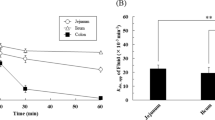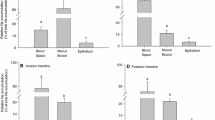Summary
-
1.
Jejunal loops of anaesthetized rats were perfused with hypotonic, isotonic, and hypertonic buffered solutions containing tritiated water or 14C-labelled urea. The blood flow of the loop was maintained constant at an intermediate rate (0.8–0.9 ml min−1 g−1 wet tissue weight). The water net flux was determined by means of polyethylene glycol as nonabsorbable marker and amounted up to ±30 μl min−1 g−1 w. w.
-
2.
A positive water net flux (directed towards the blood) increased the absorption rates (disappearance rate from the intestinal lumen, appearance rate in the intestinal venous blood) of tritiated water and urea by maximally 22 and 41%, a negative water net flux (directed towards the gut lumen) diminished it by 12 and 32%.
-
3.
The data were analysed by means of a kinetic model with the water net flux as independent variable. The sieving coefficient ⧫=1-δ was 1.18±0.44 for tritiated water and 0.86±0.11 for urea at pH 6.2. The water net flux influenced the absorption of solutes by interaction within the membranes (solvent drag in a restricted sense) and by changing the volume of blood flowing in the capillaries near the epithelium. This last effect is large for the absorption of the rapidly absorbable tritiated water, but small for the absorption of urea which is absorbed ten-times slower.
-
4.
The water net flux in the intestine depended linearly on the osmotic pressure difference between lumen and blood. The hydraulic permeability was 146–180 ml2 min−1 g−1 osm−1.
Similar content being viewed by others
References
Andersen, B., Ussing, H. H.: Solvent drag on non-electrolytes during osmotic flow through isolated toad skin and its response to antidiuretic hormone. Acta physiol. scand. 39, 228–239 (1957)
Blickenstaff, D. D.: Change in the ability of the intestine to absorb isosmotic NaCl solution following distilled water instillation. Amer. J. Physiol. 179, 467–470 (1954)
Dennis, C.: Injury to the ileal mucosa by contact with distilled water. Amer. J. Physiol. 129, 171–175 (1940)
Draper, N. R., Smith, H.: Applied regression analysis, 2nd ed. New York-London-Sidney: John Wiley and Sons, Inc. 1967
Fisher, R. B.: The absorption of water and of some small solute molecules from the isolated small intestine of the rat. J. Physiol. (Lond.) 130, 655–664 (1955)
Fordtran, J. S., Levitan, R., Bikerman, V., Burrows, B. A., Ingelfinger, F. J.: The kinetics of water absorption in the human intestine. Trans. Ass. Amer. Phycns 74, 195–206 (1961)
Fordtran, J. S., Rector, F. C., Jr., Carter, N. W.: The mechanisms of sodium absorption in the human small intestine. J. clin. Invest. 47, 884–900 (1968)
Fordtran, J. S., Rector, F. C., Jr., Ewton, M. F., Soter, N., Kinney, J.: Permeability characteristics of the human small intestine. J. clin. Invest. 44, 1935–1944 (1965)
Forth, W., Furukawa, E., Leopold, G., Rummel, W.: Vergleichende Untersuchungen über die Resorption 3H-markierter Herzglykoside. In: Radioisotope in Pharmakokinetik und klinischer Biochemie, S. 123–128. G. Hoffmann u. H.-A. Ladner, Hrsg. Stuttgart-New York: Schattauer 1970
Geigy: Documenta Geigy: Wissenschaftliche Tabellen, 7. Aufl. Basel: J. R. Geigy 1968
Goldstein, D. A., Solomon, A. K.: Determination of equivalent pore radius for human red cells by osmotic pressure measurement. J. gen. Physiol. 44, 1–17 (1960)
Hakim, A. A., Lifson, N.: Urea transport across dog intestinal mucosa in vitro. Amer. J. Physiol. 206, 1315–1310 (1964)
Herzer, R., Haberich, F. J.: Enterale Aufnahme und renale Ausscheidung von tritiummarkiertem Wasser bei wachen Ratten. Pflügers Arch. ges. Physiol. 292, 277–287 (1966)
Hindle, W., Code, C. F.: Some differences between duodenal and ileal sorption. Amer. J. Physiol. 203, 215–220 (1962).
Hyden, S.: A turbidimetric method for the determination of higher polyethylene glycols in biological materials. K. Lantbr. Högsk. Ann. 22, 139–145 (1955)
Kedem, O., Katchalsky, A.: A physical interpretation of the phenomenological coefficients of membrane permeability. J. gen. Physiol. 45, 143–179 (1961)
Lee, P. R., Code, C. F., Scholer, J. F.: The influence of varying concentrations of sodium chloride on the rate of absorption of water from the stomach and small bowel of human beings. Gastroenterology 29, 1008–1015 (1955)
Levitt, D. G., Hakim, A. A., Lifson, N.: Evaluation of components of transport of sugars by dog jejunum in vivo. Amer. J. Physiol. 217, 777–783 (1969)
Lifson, N., Gruman, L. M., Levitt, D. G.: Diffusive-convective models for intestinal absorption of D2O. Amer. J. Physiol. 215, 444–454 (1968)
Lifson, N., Hakim, A. A.: Simple diffusive-convective model for intestinal absorption of a nonelectrolyte (urea). Amer. J. Physiol. 211, 1137–1146 (1966)
Lindemann, B., Solomon, A. K.: Permeability of luminal surface of intestinal mucosal cells. J. gen. Physiol. 45, 801–810 (1962)
Magee, H. E., Reid, E.: The absorption of glucose from the alimentary canal. J. Physiol. (Lond.) 73, 163–183 (1931)
Ochsenfahrt, H.: The mucosal-serosal transfer of drugs in the rat jejunum with and without blood flow. Naunyn-Schmiedebergs Arch. Pharmak. 270, R 102 (1971)
Ochsenfahrt, H., Winne, D.: Der Einfluß der Durchblutung auf die Resorption von Arzneimitteln aus dem Jejunum der Ratte. Naunyn-Schmiedebergs Arch. Pharmak. 264, 55–75 (1969)
Ochsenfahrt, H., Winne, D.: Der Einfluß des Wassernettofluxes auf die Resorption von Arzneimitteln. Naunyn-Schmiedebergs Arch. Pharmak. 266, 414–415 (1970)
Ochsenfahrt, H., Winne, D.: The contribution of blood flow changes to solvent drag phenomenon. Life Sci. 11, Part 1 1105–1113 (1972a)
Ochsenfahrt, H., Winne, D.: Solvent drag influence on the intestinal absorption of basic drugs. Life Sci. 11, Part 1, 1115–1122 (1972b)
Shields, R.: The absorption and secretion of fluid and electrolytes by the obstructed bowel. Brit. J. Surg. 52, 774–779 (1965)
Smyth, D. H., Wright, E. M.: Streaming potentials in the rat small intestine. J. Physiol. (Lond) 182, 591–602 (1966)
Soergel, K. H., Whalen, G. E., Harris, J. A.: Passive movement of water and sodium across the human small intestinal mucosa. J. appl. Physiol. 24, 40–48 (1968)
Staverman, A. J.: The theory of measurement of osmotic pressure. Rec. Trav. chim. Pay-Bas 70, 344–352 (1951)
Ther, L., Winne, D.: Drug absorption. Ann. Rev. Pharmacol. 11, 57–70 (1971)
Visscher, M. B., Fetcher, E. S., Jr., Carr, C. W., Gregor, H. P., Bushey, M. S., Barker, D. E.: Isotopic tracer studies on the movement of water and ions between intestinal lumen and blood. Amer. J. Physiol. 142, 550–575 (1944)
Vogel, G. Becker, U., Ullrich, M.: The relevance of the osmolarity of the instillation fluid to the “effectiveness” and “toxicity” of drugs given by the intraduodenal route. Naunyn-Schmiedebergs Arch. Pharmacol 277, R 85 (1973)
Wang, J. H., Robinson, C. V., Edelman, I. S.: Self-diffusion and structure of liquid water. III. Measurement of the self-diffusion of liquid water with 2H, 3H and 18O as tracers. J. Amer. chem. Soc. 75, 466–470 (1953)
Williams, A. W.: Experimental production of altered jejunal mucosa. J. Path. Bact. 85, 467–472 (1963)
Winne, D.: Die Pharmakokinetik der Resorption bei Perfusion einer Darmschlinge mit variable Durchblutung. Naunyn-Schmiedebergs Arch. Pharmak. 268, 417–433 (1971)
Winne, D.: The influence of blood flow and water net flux on the absorption of tritiated water from the jejunum of the rat. Naunyn-Schmiedeberg's Arch. Pharmacol. 272, 417–436 (1972)
Winne, D., Remischovsky, J.: Der Einfluß der Durchblutung auf die Resorption von Harnstoff, Methanol und Äthanol aus dem Jejunum der Ratte. Naunyn-Schmiedebergs Arch. Pharmak. 268, 392–416 (1971a)
Winne, D., Remischovsky, J.: Der Einfluß der Durchblutung auf die Resorption von Polyalkoholen aus dem Jejunum der Ratte. Naunyn-Schmiedebergs Arch. Pharmak. 270, 22–40 (1971b)
Author information
Authors and Affiliations
Rights and permissions
About this article
Cite this article
Ochsenfahrt, H., Winne, D. The contribution of solvent drag to the intestinal absorption of tritiated water and urea from the jejunum of the rat. Naunyn-Schmiedeberg's Arch. Pharmacol. 279, 133–152 (1973). https://doi.org/10.1007/BF00503979
Received:
Issue Date:
DOI: https://doi.org/10.1007/BF00503979




